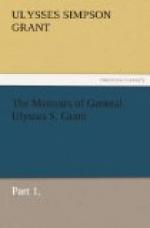But General Scott’s successes are an answer to all criticism. He invaded a populous country, penetrating two hundred and sixty miles into the interior, with a force at no time equal to one-half of that opposed to him; he was without a base; the enemy was always intrenched, always on the defensive; yet he won every battle, he captured the capital, and conquered the government. Credit is due to the troops engaged, it is true, but the plans and the strategy were the general’s.
I had now made marches and been in battle under both General Scott and General Taylor. The former divided his force of 10,500 men into four columns, starting a day apart, in moving from Puebla to the capital of the nation, when it was known that an army more than twice as large as his own stood ready to resist his coming. The road was broad and the country open except in crossing the Rio Frio mountain. General Taylor pursued the same course in marching toward an enemy. He moved even in smaller bodies. I never thought at the time to doubt the infallibility of these two generals in all matters pertaining to their profession. I supposed they moved in small bodies because more men could not be passed over a single road on the same day with their artillery and necessary trains. Later I found the fallacy of this belief. The rebellion, which followed as a sequence to the Mexican war, never could have been suppressed if larger bodies of men could not have been moved at the same time than was the custom under Scott and Taylor.
The victories in Mexico were, in every instance, over vastly superior numbers. There were two reasons for this. Both General Scott and General Taylor had such armies as are not often got together. At the battles of Palo Alto and Resaca-de-la-Palma, General Taylor had a small army, but it was composed exclusively of regular troops, under the best of drill and discipline. Every officer, from the highest to the lowest, was educated in his profession, not at West Point necessarily, but in the camp, in garrison, and many of them in Indian wars. The rank and file were probably inferior, as material out of which to make an army, to the volunteers that participated in all the later battles of the war; but they were brave men, and then drill and discipline brought out all there was in them. A better army, man for man, probably never faced an enemy than the one commanded by General Taylor in the earliest two engagements of the Mexican war. The volunteers who followed were of better material, but without drill or discipline at the start. They were associated with so many disciplined men and professionally educated officers, that when they went into engagements it was with a confidence they would not have felt otherwise. They became soldiers themselves almost at once. All these conditions we would enjoy again in case of war.




